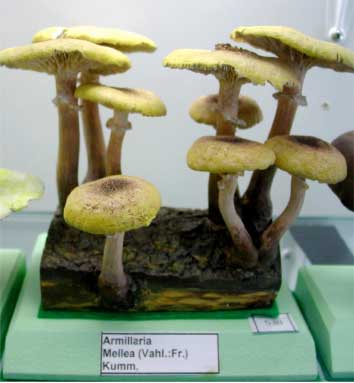|
The Fungi
|
||||||||||||
|
|
||||||||||||
 |
||||||||||||
|
Armillaria mellea (Honey Fungus). (Photo F. Padovan)
|
||||||||||||
|
|
||||||||||||
|
A well endowed collection of fungi (micoteca) is on display here. All together 184 species are on show as models, reproduced in their natural size (scale 1 : 1), made using moulds by Ivan Fossa.
They include the most common and widespread fungi in Alpago, both edible and poisonous. Among the edible we find, for example, the boletus (Boletus aestivalis), the chanterelle (Cantharellus cibarius), and the parasol mushroom (Macrolepiota procera) and many others; among the poisonous there is the deadly death cap (Amanita phalloides), very common in Alpago and the related white fly agaric (Amanita muscaria), the devil’s boletus (Boletus satanas) and the Clitocybe rivulosa. They are displayed in a double show case (cod. 61 & 62) in the centre of the room. Each model is labelled with its scientific name and code number and further information is soon to be provided on whether the species displayed are edible or poisonous, their popular or local names and most frequent literary references. Above the glass show cases there are two explanatory panels: one giving the main morphological characteristics of the fruit body of an agaricus (by agaricus is meant the typical mushroom shape with cap, lamellae and stalk) and some structural and reproductive differences between the Ascomycetes and the Basidiomycetes; the other shows the ecology of fungi with the three main kinds of relationship to plants – mycorrhiza (symbiotic association of fungus hyphae with the roots of green plants), saprophytism (living on dead organisms, their remains and on organic matter or mineral soils) and parasitism (on living organisms, deriving nourishment from them and in so doing damaging them). |
||||||||||||
|
|
||||||||||||
|
||||||||||||